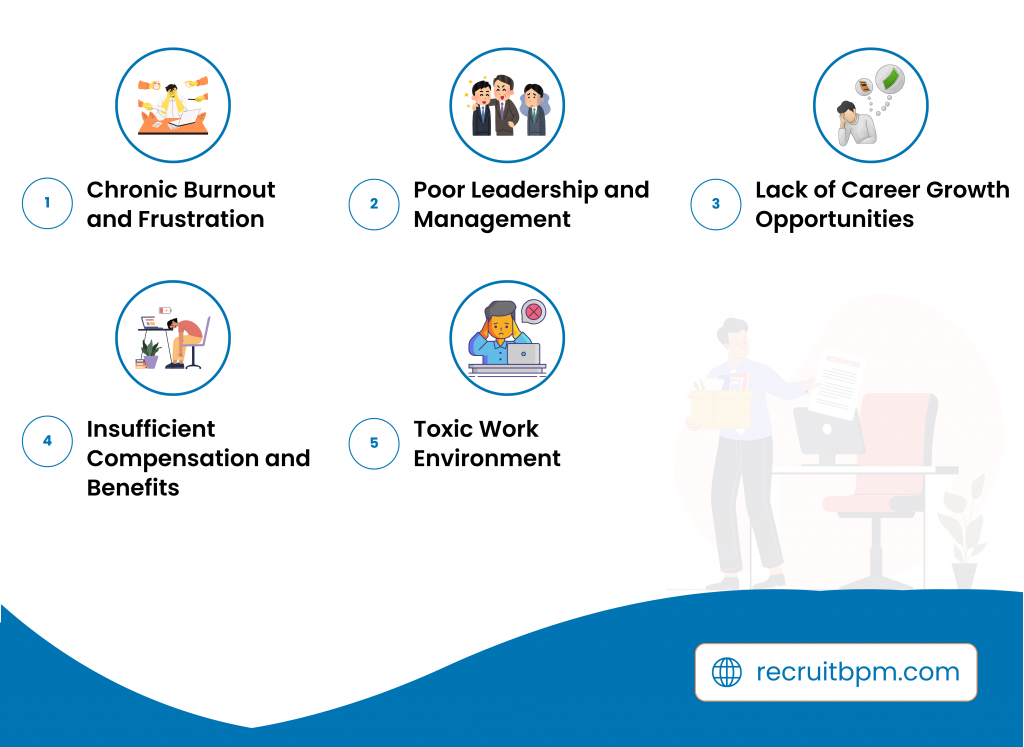Employee disengagement has evolved beyond quiet withdrawal. Today’s workforce is making noise about dissatisfaction in ways that shake organizational foundations.
What Is Loud Quitting?
Loud quitting describes employees who actively disengage from their roles while vocally expressing discontent. Unlike those who silently reduce effort, loud quitters make their frustration known through public complaints, deliberate underperformance, and visible opposition to leadership.
Recent data shows that 15% of employees are actively disengaged, directly harming organizations and opposing company leadership. These individuals don’t simply check out mentally. They create disruption that ripples through teams and damages company culture.
Why Loud Quitting Matters for Recruiters?
Recruitment professionals face unique challenges when loud quitting occurs. Talent acquisition becomes harder when former employees publicly criticize your organization. Your employer brand suffers damage that takes months to repair.
Loud quitting signals deeper cultural issues that make attracting quality candidates difficult. Prospective hires research companies thoroughly. They read reviews, check social media, and talk to former employees. One dramatic exit can deter dozens of potential applicants.
Loud Quitting vs. Quiet Quitting: Key Differences
Understanding Quiet Quitting
Quiet quitting involves employees who remain employed but become emotionally disconnected, reducing discretionary effort. These workers complete minimum job requirements without enthusiasm or additional contribution. They withdraw from non-essential activities while maintaining basic performance standards.
How Loud Quitting Differs?
Loud quitters take an opposite approach. Their disengagement is visible, confrontational, and intentionally disruptive. While quiet quitters fade into the background, loud quitters demand attention through vocal criticism and defiant behavior.
The key difference lies in intent and impact. Quiet quitting affects individual productivity gradually. Loud quitting creates immediate organizational disruption that spreads quickly through teams.
Which Is More Damaging to Organizations?
Both behaviors harm companies, but in different ways. Quiet quitting causes slow productivity erosion that compounds over time. Organizations lose an estimated $8 trillion globally due to low employee engagement.
Loud quitting creates sudden crises with lasting repercussions. A single dramatic exit can trigger additional resignations, damage recruitment efforts, and tarnish your company’s reputation publicly. The immediate visibility makes loud quitting particularly dangerous for employer branding.
Common Loud Quitting Examples
Sending Company-Wide Criticism Emails
Some departing employees send scathing farewell messages to entire organizations. These emails detail perceived injustices, criticize leadership decisions, and call out toxic behaviors. Even when not shared externally, these messages create internal chaos and embolden other dissatisfied workers.
Public Social Media Resignations
Loud quitting often becomes public on social media platforms, where employees share their discontent and intention to leave. Platforms like LinkedIn, Twitter, and TikTok give employees global audiences for their grievances. Posts can go viral, magnifying damage to your organization’s reputation.
Refusing Job Duties in Front of Peers
Loud quitters sometimes openly refuse tasks, declaring them “not their responsibility” in team settings. This public defiance challenges authority and encourages others to question leadership decisions. The behavior undermines manager’s credibility and creates uncomfortable team dynamics.
Posting Negative Company Reviews Online
Within hours of resigning, some employees post detailed negative reviews on Glassdoor, Indeed, or social media. These reviews highlight specific complaints about management, culture, or compensation. Future candidates read these reviews when evaluating job offers.
Walking Out Mid-Shift
The most dramatic form involves employees leaving during work hours without notice. Often triggered by confrontations with managers, these exits leave teams scrambling and send clear messages about workplace problems.
What Causes Loud Quitting?

Chronic Burnout and Frustration
Prolonged overwork without recognition builds resentment. When employees feel exhausted and undervalued simultaneously, frustration accumulates. Eventually, something triggers an explosive release of pent-up emotions.
Work-life balance matters deeply to modern workers. Research shows that 65% of employees want more control over their work hours and project assignments. Organizations that ignore these needs create conditions where loud quitting becomes likely.
Poor Leadership and Management
Ineffective leaders create disengaged teams. Micromanagement, inconsistent expectations, and lack of transparency erode trust. When employees don’t feel supported or respected, they become vocal about dissatisfaction.
Nearly all workers want inspiring leadership, yet only 36% report having leaders who inspire them. This gap between expectation and reality fuels frustration that sometimes explodes into loud quitting.
Lack of Career Growth Opportunities
Employees who see no advancement path become restless. Stagnation breeds resentment, especially when workers invest effort without seeing returns. Organizations that fail to develop talent internally push ambitious employees toward dramatic exits.
Insufficient Compensation and Benefits
Fair pay is foundational to job satisfaction. When employees discover they’re underpaid compared to market rates or internal peers, resentment grows. Compensation grievances often feature prominently in loud quitting incidents.
Toxic Work Environment
Toxic workplaces characterized by disrespect, poor communication, and unreasonable expectations often catalyze loud quitting. Employees use dramatic departures to highlight unhealthy dynamics and reclaim personal power.
Warning Signs of Loud Quitting
Declining Performance and Productivity
Notice when previously reliable employees miss deadlines or produce lower-quality work. These performance drops often signal growing disengagement. Attention to detail suffers as commitment wanes.
Increased Workplace Conflict
Frequent arguments with colleagues or managers indicate rising frustration. Confrontational tones in meetings and difficulty collaborating suggest an employee is approaching their breaking point.
Public Complaints About Company Policies
Vocal frustration about leadership, workload, or policies in shared spaces deserves attention. When employees stop containing complaints to private conversations, they’re signaling serious dissatisfaction.
Refusing New Responsibilities
Employees who say “that’s not my job” or decline stretch assignments may be mentally checking out. This resistance to growth opportunities shows declining investment in their role.
Social Media Venting
Even vague posts criticizing workplaces serve as early warnings. Employees testing the waters publicly may be building toward more dramatic actions.
The Psychology Behind Loud Quitting
Need for Recognition and Validation
When employees feel overlooked or unheard, loud quitting serves as their final outcry for recognition of grievances. The dramatic nature ensures their concerns cannot be ignored or minimized.
Desire for Closure
People need clear-cut endings to relationships, which loud quitting provides despite its dramatic nature. The definitive break offers psychological closure that quiet resignation might not deliver.
Workplace Stress and Breaking Points
Research indicates that 56% of actively disengaged employees report feeling significant daily stress compared to 30% of engaged employees. High-pressure environments without adequate support push people past tolerance limits.
Unexpressed Anger and Resentment
Loud quitting releases accumulated anger. When employees suppress frustrations over extended periods, the eventual expression becomes more intense and public.
Role of Ego in Dramatic Exits
The human ego’s need for affirmation drives dramatic exits as employees seek to leave memorable impressions. Making a statement satisfies the desire to be remembered and taken seriously.
Impact of Loud Quitting on Organizations
Damage to Team Morale
When one employee quits loudly, others take notice. Tension rises as remaining team members question whether they should stay. Collaboration suffers when trust breaks down between staff and leadership.
Increased Employee Turnover
Loud quitting can trigger additional resignations. Employees who were already considering leaving feel emboldened. Those valuing stable environments may seek opportunities elsewhere.
Recruitment and onboarding costs multiply quickly. Experienced employees leaving takes institutional knowledge out the door. New hires require time to reach full productivity.
Reputation and Employer Brand Harm
Social media platforms serve as global stages for employees to broadcast dramatic resignations, magnifying reach and impact. Viral posts damage your ability to attract talent for months or years.
Negative reviews remain online indefinitely. Prospective candidates see these stories when researching your organization. Your talent acquisition team faces steeper challenges in competitive markets.
Financial Costs and Recruitment Challenges
Beyond direct replacement costs, loud quitting creates hidden expenses. Team productivity drops during transitions. Training new employees requires significant time investment. Lost opportunities compound when positions stay vacant.
How To Prevent Loud Quitting?
Foster Open Communication Channels
Create safe spaces where employees share concerns without fear. Regular check-ins beyond annual reviews show you value ongoing dialogue. Anonymous feedback tools help surface issues before they escalate.
When people feel heard early, they’re less likely to resort to dramatic measures. Addressing problems promptly prevents frustration from building to explosive levels.
Provide Regular Recognition and Appreciation
Simple acknowledgment makes meaningful differences. Public recognition, peer appreciation programs, and thoughtful rewards reinforce that contributions matter. Employees who feel valued rarely quit loudly.
Prioritize Employee Well-Being
Set reasonable workload expectations and respect boundaries. Flexible arrangements show you value work-life balance. Mental health support demonstrates genuine care for employee wellness.
Treating well-being as a priority rather than an afterthought prevents burnout that leads to loud quitting.
Invest in Career Development
Provide clear advancement paths and growth opportunities. Learning programs, mentorship, and skill development show investment in employee futures. People who see possibilities ahead stay engaged.
Strengthen Manager Effectiveness
Train leaders in empathy, transparency, and consistent communication. Strong managers catch disengagement early and address concerns effectively. Poor supervision drives more loud quitting than any other factor.
Addressing Loud Quitters: Best Practices
Responding Without Escalation
Stay calm when faced with dramatic resignations. Reacting emotionally worsens situations. Document incidents professionally while avoiding defensive responses.
Documentation and Compliance
Follow established policies consistently. Write down conversations and actions taken. Proper documentation protects your organization legally and ensures fair treatment.
Protecting Remaining Team Members
Address team concerns promptly after loud quitting incidents. Be transparent about the steps you’re taking to improve culture. Show remaining employees that their voices matter.
Managing Public Relations Fallout
Respond professionally to public criticisms without becoming defensive. Focus on improvements you’re implementing rather than attacking departing employees. Demonstrating accountability builds credibility.
The Future of Employee Disengagement
Trends in Workplace Satisfaction
Current data shows that only 23% of employees report being fully engaged at work. This engagement crisis requires urgent attention from organizational leaders.
Younger workers increasingly prioritize meaningful work, growth opportunities, and healthy cultures over traditional benefits. Organizations adapting to these expectations will reduce disengagement.
Role of Technology in Prevention
Advanced analytics help identify disengagement patterns before crises occur. Pulse surveys and sentiment analysis provide early warning systems. Technology enables proactive intervention.
Building Resilient Company Culture
Creating cultures where feedback flows freely prevents frustration buildup. Psychological safety allows employees to voice concerns constructively. Resilient cultures absorb challenges without triggering dramatic exits.
Organizations prioritizing transparency, fairness, and genuine care for employees will see less loud quitting. The investment in culture pays dividends through retention and reputation.
Loud quitting reflects serious organizational issues that demand attention. While dramatic exits create immediate crises, they also provide opportunities. Listen to the messages behind the noise. Address root causes rather than symptoms.
Prevention starts with building workplaces where people feel heard, valued, and respected. Open communication, fair treatment, and genuine investment in employee success create environments where loud quitting becomes unnecessary.
Your talent acquisition strategy depends on your reputation. Every loud quitting incident makes recruiting harder. Conversely, every employee who leaves satisfied becomes an ambassador for your brand.
The choice is yours. Build cultures that inspire loyalty or continue managing crises. Organizations that take employee engagement seriously will thrive in competitive talent markets.

















